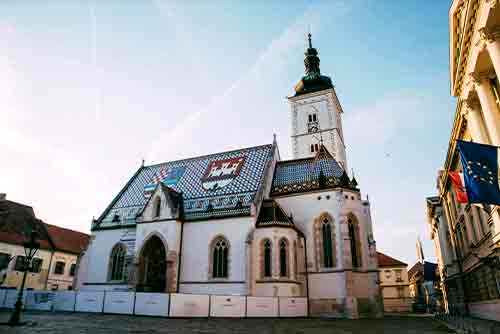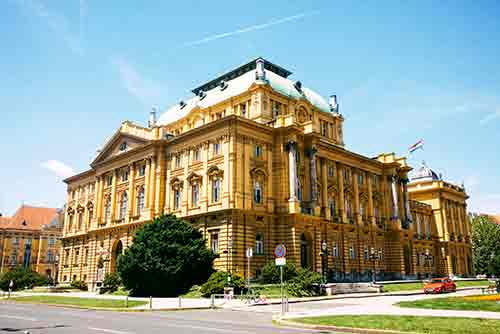Top 5 Must-Sees in Zagreb
Zagreb is the capital and transportation hub of Croatia. Zagreb is also a great city to explore on foot, as all the main attractions are close to each other. Here’s a walking tour that will help you conquer the city in a short amount of time.
Croatia : Travel Information And Tips
5 Best Bang for the Buck Hotels in Zagreb
1. Ban Josip Jelačić Statue
A square located in the center of Zagreb. It’s the center of the Old Town with the most foot traffic. Many tram lines run through it and it’s easy to get around. The main tourist attractions are also within walking distance, making it a good starting point for sightseeing. The name of the square has changed several times in the past, starting with Mandusevac, named after the fountain.
In 1848, it was called Ban Jelacic Square, as it is now, after the ruler of the time, but after World War II, the communists renamed it Republic Square and removed the statue of Ban Josip Jelacic. After independence from the Federal Republic of Yugoslavia in 1991, the square regained its current name, Ban Jelacic Square. There is a small fountain on one side of the square, which is often used as a meeting place.
There are also palaces and cafes around the square, and folk festivals are held here in the summer. At this time, the square is transformed into a large stage. In the center of the square is a statue of Van Zelazik.
2. Stone Gate (Kamenita vrata)
This stone gate was the dividing line between the upper and lower towns in the Middle Ages. The Gate of Stones is famous not only because it is a medieval structure but also because of the Great Fire of 1731 in Zagreb.
During the Great Fire, most of the surrounding buildings were burned down, but the painting of the Virgin Mary on the Stone Gate was the only thing that remained untouched. As a result, it was revered for its miraculous powers and became a pilgrimage site. Legend has it that it was here, in the middle of the ashes, that the Virgin Mary was found, with only the frame burned but not the painting. Later, a baroque altar was built in the depths of the Stone Gate and the painting was placed on it.
Built in the 13th century, the gate is already 700 years old and is the northernmost of the four gates that surround the Old Gradec neighborhood. The current structure, with the painting of the Virgin Mary on the door, was rebuilt in 1760.
In 1778, an elaborate baroque iron gate was built around the altar. The golden crown in the painting was added in 1931.
3. Museum of Broken Relationships
(Muzej prekinutih veza)
Zagreb’s Museum of Broken Relationships (Muzej prekinutih veza) opened in 2010 with objects donated by people from all over the world who had broken up with someone, and in 2011 it was named the most groundbreaking museum by the European Museum Forum.
The idea for the museum came from a Zagreb couple, a filmmaker and a female painter, who broke up after four years of dating and wondered what to do with the objects left over from their relationship.
In Zagreb, there is a museum dedicated to broken relationships. The name alone is enough to catch your attention, as it’s a unique theme that you won’t find anywhere else.
In fact, the museum isn’t just about broken relationships. The museum has a collection of breakups from all over the world, including family and friends. Listening to the stories of different people’s breakups can be as funny as a friend’s story or as weird as your own.

4. St. Mark’s Church, Zagreb
(Crkva sv. Marko)
St. Mark’s Church is already one of Zagreb’s most recognizable landmarks, thanks to its unique facade that reminds me of Lego.
It was built in 1256 and is located in the center of Markov Square. In the second half of the 14th century, it underwent a major renovation and became Gothic.
It is said that the development of the Gradec district began in the Middle Ages with the construction of St. Mark’s Church.
The roof is famous for its beautiful red, blue, and white checkered roof, with colorful mosaics of the country’s and state’s insignia: the left insignia is the symbol of Croatia, and the right insignia is the symbol of Zagreb.The exterior of the church is Gothic, but the windows are finished in Romanesque style.
Inside the cathedral are sculptures of Jesus and the Virgin Mary holding Jesus, as well as sculptures of Jesus’ 12 disciples, all by Croatian sculptor Ivan Mesutrović. These statues are considered to be European treasures.
5. Funicular Uspinjača
One of Zagreb’s highlights, this funicular connects the Upper Town to the Lower Town and is one of the shortest funiculars in the world. The travel distance is only 66 meters and the ride time is exactly 64 seconds. The cable car was inaugurated in 1890, a year before the horse-drawn trams, so it is actually the oldest form of public transportation in Zagreb.
The cable car runs every 10 minutes from 6:30 am to 10 pm every day. Tickets cost less than 1€, but you can also use tickets for other public transportation.If you don’t want to ride the funicular, there is a staircase next to it where you can see the original structure.
The funicular offers a panoramic view of Zagreb from the top. Right next door is the Rotrščak Tower, which you can visit together. It’s actually not that far away, so you can walk up, but it’s worth it to take a funicular ride at least once.



